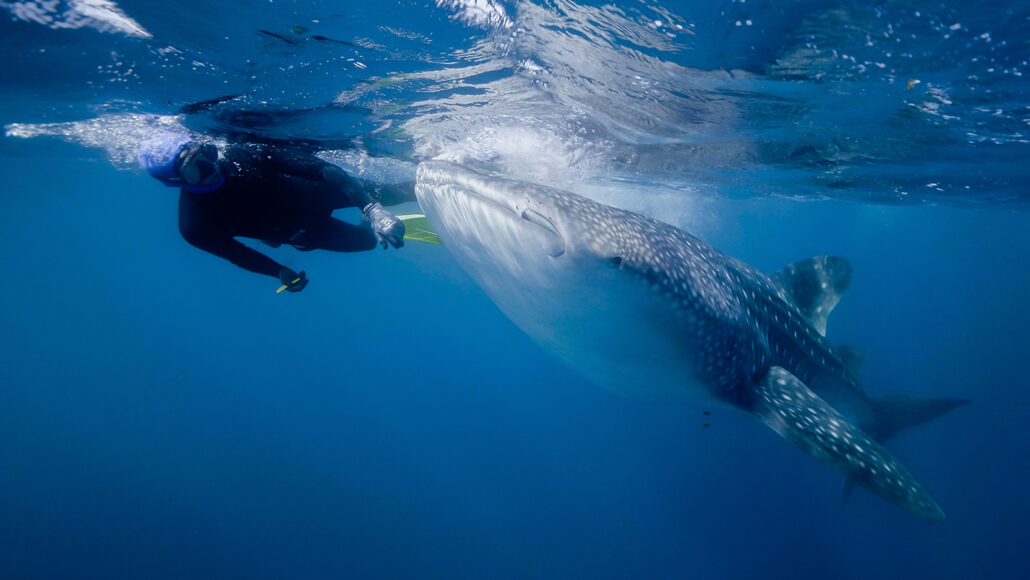Whale sharks may be the world’s largest omnivores
The giant fish, long assumed to be strict meat-eaters, eat and digest algae

Tropical fish biologist Mark Meekan (pictured) gets up close and personal with a whale shark off the coast of Australia. He and his colleagues collect and study tissue samples to learn about what these ocean giants eat.
Andre Rerekura/AIMS
By Freda Kreier
As Mark Meekan bobbed among swells in the Indian Ocean, he spotted a giant shadowy figure moving through the water. He dove to meet the gentle giant — a whale shark. With a hand spear, he took small samples of its skin. Those bits of skin are helping Meekan learn more about how these mysterious titans live — including what they like to eat.
Swimming alongside these aquatic giants is nothing new for Meekan. He’s a tropical fish biologist at the Australian Institute of Marine Science in Perth. But even so, each sighting is special, he says. “Having an encounter with something that feels like it’s from prehistory is an experience that never gets old.”
The whale shark (Rhincodon typus) is the largest living fish species. It averages around 12 meters (about 40 feet) long. It’s also among the most mysterious. These sharks spend most of their lives in the deep ocean, making it hard to know what they’re up to. Scientists like Meekan study the chemical makeup of their tissues. Chemical clues can reveal a lot about the animals’ biology, behavior and diet.
When Meekan’s team analyzed the shark skin samples, they found a surprise: Whale sharks, long thought to be strict meat-eaters, also eat and digest algae. The researchers described the finding July 19 in Ecology. It’s the latest piece of evidence that whale sharks eat plants on purpose. That behavior makes them the world’s largest omnivores — by a lot. The previous record-holder, the Kodiak brown bear (Ursus arctos middendorffi), averages about 2.5 meters (8.2 feet) in length.

Educators and Parents, Sign Up for The Cheat Sheet
Weekly updates to help you use Science News Explores in the learning environment
Thank you for signing up!
There was a problem signing you up.
Eating their greens
Algae has turned up before in the stomachs of beached whale sharks. But whale sharks feed by swimming mouth-open through swarms of zooplankton. So “everyone thought it was just accidental ingestion,” Meekan says. Carnivores typically can’t digest plant life. Some scientists suspected that algae passed through whale sharks’ guts without being digested.
Meekan and colleagues wanted to find out if that assumption held up. They went to Ningaloo reef off the coast of Western Australia. Whale sharks gather there each fall. The gigantic fish are well camouflaged. They’re hard to spot from the sea surface. So the team used an airplane to locate 17 individuals that had surfaced to feed. The researchers then zipped over to the sharks by boat and jumped into the water. They snapped pictures, scraped off parasites and collected tissue samples.
Most whale sharks don’t react when they get jabbed by the spear, Meekan says. (The spear is roughly the width of a pinky finger.) Some even seem to enjoy attention from researchers, he says. It’s as though they think: “This isn’t threatening. In fact, I quite like that.”
The whale sharks at Ningaloo reef had high levels of arachidonic (Uh-RAK-ih-dahn-ik) acid. That’s an organic molecule found in a type of brown algae called sargassum. Sharks can’t make this molecule themselves, Meekan says. Instead, they probably got it by digesting algae. It’s not yet clear how arachidonic acid affects whale sharks.
Previously, another group of researchers found plant nutrients in the skin of whale sharks. Those sharks lived off the coat of Japan. Taken together, the findings suggest that it’s common for whale sharks to eat their greens.
But that doesn’t mean whale sharks are true omnivores, says Robert Hueter. He’s a shark biologist at Mote Marine Laboratory in Sarasota, Fla. “Whale sharks take in a lot of other things than the food they’re targeting,” he says. “This is a bit like saying that cows are omnivores because they eat insects while feeding on grass.”
Meekan admits he can’t say for certain that whale sharks specifically seek out sargassum. But it’s clear from his team’s analysis that the sharks eat quite a bit of it. Plant material makes up a very large part of their diet. So much, in fact, that whale sharks and the zooplankton that they also eat seem to occupy similar rungs on the marine food chain. Both sit just one rung above the phytoplankton they both feast upon.
Whether or not whale sharks actively seek out plant snacks, the animals can clearly digest them, Meekan says. “We don’t see whale sharks that often. But their tissues hold a remarkable record of what they’ve been up to,” he says. “We’re now learning how to read this library.”







